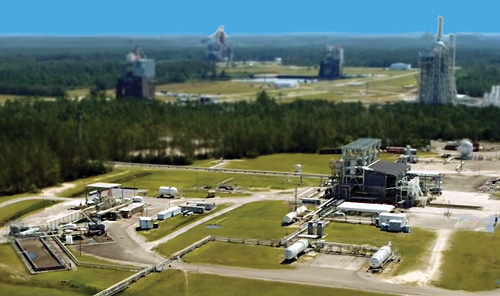As a group, the Southern States benefit from access to the Mississippi River, “an international gateway at the Louisiana Gulf Coast that provides commercial access to two-thirds of U.S. states,” according to Pierson. This locational advantage adds to “the combination of attractive labor markets, strong business climates, and seasonable weather conditions [to create] a region that’s highly conducive to manufacturing and other key industries.” Pierson continues, “The region represents a truly positive destination for domestic and foreign direct investment. The recent expansion of the Panama Canal creates even greater international commerce opportunities, with more efficient access to Pacific Rim markets.”
“We see a lot of strength around manufacturing,” notes Bradley Jackson, president and CEO of the Tennessee Chamber of Commerce and Industry. “We call it onshoring — operations coming back to North America and even foreign manufacturing companies looking to expand or put operations in North America — and fortunately the Southeast is a region where they frequently end up coming.”
Pierson agrees: “The collective investment and job creation by manufacturers in the aerospace, automotive, metal, forest products, logistics, and plastics sectors help drive economic growth for the entire region.”
The Automotive Corridor
In recent decades, the entrenchment of the auto manufacturing industry has led to an overhaul of the regional economy. “In the 1980s, automotive manufacturers — particularly Asian and European automakers — and their supplier networks (OEMs) began tapping the South’s opportunity-hungry states, underutilized labor force, available land, and beneficial climate,” says Jack Mazurak, communications director for the Kentucky Cabinet for Economic Development. “That led to nearly 40 years of well-documented development of the Southern automotive corridor.”
The South now includes several of the nation’s top automotive-producing states, including Tennessee, which ranks second to Michigan in the country in auto production, and Kentucky, the No. 1 producer of passenger vehicles per capita and third-largest producer of them overall.
Mazurak says part of the economic boost the auto industry provides is the large array of related businesses that bloom around auto plants, spurring growth in the plastics, glass, rubber, and chemical industries, among others, as well as a surge in service providers, such as logistics businesses.
“Within the Southern automotive corridor, a robust network of suppliers developed to meet the rising demand from automakers,” Mazurak notes. “That includes primary producers of steel and aluminum — used in body and structural panels — and downstream processors and fabricators. Steel and iron production continues as a mainstay in the South, and the aluminum industry continues seeing meteoric growth, as it has for the past several years.” In Kentucky, for instance, aluminum-related companies have announced about 100 new-facility or expansion projects since the start of 2014, totaling more than $3.4 billion in expected investment, according to Mazurak. Steel jobs have grown 39 percent since 2009 in Arkansas.
Ultimately, Mazurak says, “Automotive development brought advanced manufacturing across the South, including a whole supply chain of factory-systems providers that became increasingly adept with robotics, programming, and other tech-enabled products.”
Diverse Manufacturing Strength
The Southern States have drawn advanced manufacturing companies such as those in the aerospace sector as well as more resource-based-firms, like those that rely on Arkansas timber.
-
Michoud Assembly Facility
New Orleans, LALouisiana has attracted a variety of aerospace projects in recent years, including the expansion of NASA’s Michoud Assembly Facility in New Orleans, where a collection of companies are assembling major components for the next U.S. space flights.
-
NASA’s Stennis Space Center
Hancock County, MSMississippi is home to NASA’s Stennis Space Center in Hancock County, where SpaceX has its rocket engine testing program and Relativity Space announced in 2019 that it was investing $59 million to expand its rocket component production and rocket engine testing operations.
-
Airbus
Mobile, ALIn a 2020 announcement that Airbus would be increasing its production of A320 aircraft at its Mobile plant, company CEO Jeffrey Knittel noted, “We have invested more than $1 billion in Mobile because of the terrific team of employees there — and because of the support and welcome we continue to receive from the Gulf Coast community and state and congressional leaders.”
-
Structurlam Mass Timber Corporation
Conway, ARCanada-based Structurlam Mass Timber Corporation chose Conway, Ark., for its first U.S. plant to be near Walmart. The company is “the exclusive supplier of mass timber products for its new home office campus,” said Hardy Wentzel, CEO of Structurlam.
The aerospace industry also has flourished in the Southern States. Louisiana, for example, has attracted a variety of aerospace projects in recent years, including the expansion of NASA’s Michoud Assembly Facility in New Orleans, where a collection of companies are assembling major components for the next U.S. space flights.
“A regional boon for the aerospace industry is the Aerospace Alliance, a compact of Louisiana, Mississippi, Alabama, and Florida for the advancement of an aerospace sector that employs 200,000 people and features 18 higher education institutions offering advanced aviation and aerospace degrees,” Pierson explains.
Mississippi is home to NASA’s Stennis Space Center in Hancock County, where SpaceX has its rocket engine testing program and Relativity Space announced in 2019 that it was investing $59 million to expand its rocket component production and rocket engine testing operations. The state has also proven to be a popular location for companies researching and producing unmanned aerial systems. Alabama is host to a variety of major aerospace efforts as well — from organizations such as NASA to United Launch Alliance, Boeing, GE, Blue Origin, Airbus, and Dynetics.
“We have invested more than $1 billion in Mobile because of the terrific team of employees there — and because of the support and welcome we continue to receive from the Gulf Coast community and state and congressional leaders,” C. Jeffrey Knittel, CEO of Airbus, noted in a press release after a 2020 announcement that the company would be increasing its production of A320 aircraft at its Mobile plant.
In an effort to provide the workforce that their manufacturers need, the Southern States have made workforce training a priority. Diversification
Each state has its own strengths, particularly as it seeks to further diversify its economy. In Tennessee, for example, Jackson says the state is seeing encouraging growth in technology, finance, and healthcare. Meanwhile, Louisiana’s chemical manufacturing industry is the biggest driver of state GDP in its manufacturing sector. The chemical industry is responsible for $80 billion in annual sales for businesses in Louisiana, along with nearly 30,000 direct jobs with an average annual salary of $106,000 — as well as the creation of eight indirect jobs for each direct job, according to Pierson.
Arkansas is a top exporter of rice, soybeans, cotton, poultry, and feed grains, ranking first in the U.S. in rice production and third in cotton. Arkansas is also the fourth-leading softwood lumber producer in the country. Eight Fortune 1000 companies are based in the state, which has the third-lowest cost of living in the country according to CNBC — including most prominently Walmart, the largest retailer in the world.
Those companies attract other businesses. For instance, Canada-based Structurlam Mass Timber Corporation, the leading mass timber manufacturer in North America, chose Conway, Ark., for its first U.S. plant to be near Walmart. “We’re proud to establish roots in the City of Conway and support Walmart as the exclusive supplier of mass timber products for its new home office campus,” said Hardy Wentzel, CEO of Structurlam, in a press release.
Kentucky, meanwhile, is targeting agritech as a rich opportunity. “State leaders see an opportunity to become a leader in agritech,” Mazurak says. “To achieve the vision, Kentucky is working to link its advanced manufacturing expertise and workforce training abilities with the commonwealth’s deep agricultural resources. The state is putting in place objectives to grow its own best ideas into prosperous agritech businesses, attract expansions from abroad, and to nurture Kentucky’s existing agritech companies with the goal of creating tech-enabled jobs for Kentuckians.”
Emphasizing Workforce Training
Despite evidence of growth, these six states all appear near the bottom of rankings of median income, and each is among the 10 states with the highest poverty rates in the country. They also were listed among the 10 least-educated states in the country in WalletHub’s 2020 rankings. In an effort to provide the workforce that their manufacturers need, these Southern States have made workforce training a priority.
In Louisiana, for instance, Pierson says Louisiana Economic Development has helped lead public-private partnerships featuring $300 million in targeted higher education investments that link private employers with public colleges and universities. Curricula consequently are tailored for high-demand occupations, such as for jobs tied to computer science, STEM, and advanced manufacturing. Pierson says the higher ed programs have spurred major new technology investments in the state.
“We’re seeing great results in helping existing employers in Louisiana expand, and in attracting new employers, including FDI,” Pierson says. “For the past decade, Louisiana is one of only three states to attract over $100 billion in FDI activity (along with California and Texas), and we’re No. 1 by far on a per capita basis,” Pierson notes.
Additionally, through FastStart, Louisiana’s highly regarded workforce training program, customized programs are created to ensure companies’ workers are prepared on day one of operations and beyond.
According to Mazurak, Kentucky’s universities and community and technical colleges have created bespoke programs to develop workers with certain skills, such as with the Registered Apprenticeships and the KY Federation for Advanced Manufacturing Education (KY FAME) programs, as well as through growth in established colleges of engineering.
Tennessee has received national plaudits for Tennessee Promise, a last-dollar scholarship program that pays for state students’ tuition and mandatory fees after other financial aid has been exhausted at an assortment of postsecondary institutions that offer two-year, associate degrees. And Tennessee Reconnect helps adults older than 25 attend higher education institutions.
“We’re putting a lot of emphasis on workforce development because we know that ultimately for companies, their labor force, their employees, that’s their most important asset,” Jackson says. “So we have worked to demonstrate and really create a pipeline of students with the technical skills and interest — identifying them in high school and helping them to obtain the certifications or their associate’s degree. And we’ve worked hard to make sure that those align with the job market and with the job demands of the future.”




